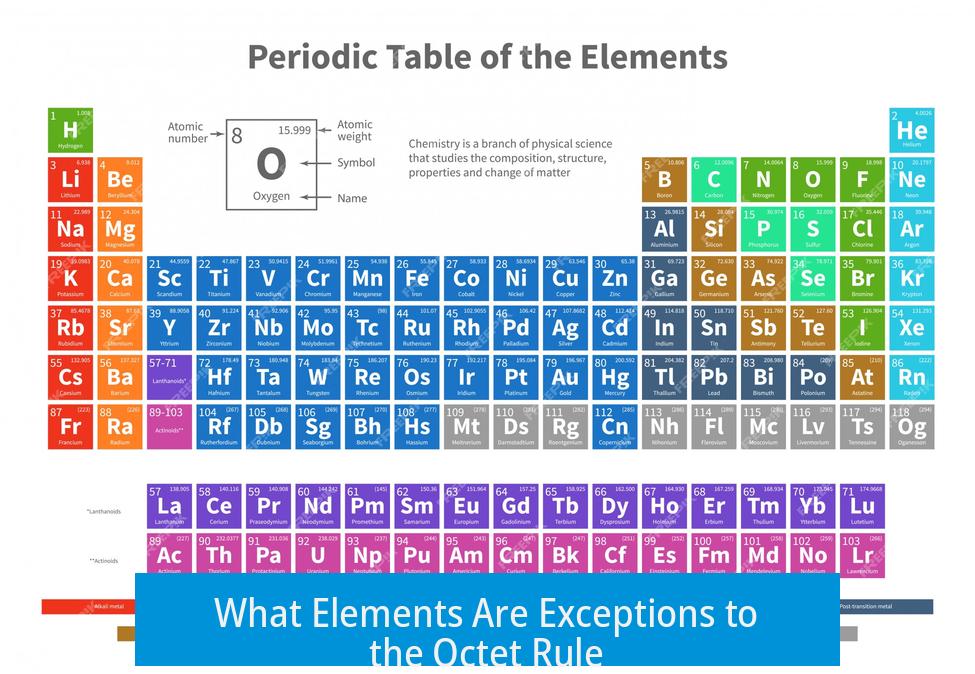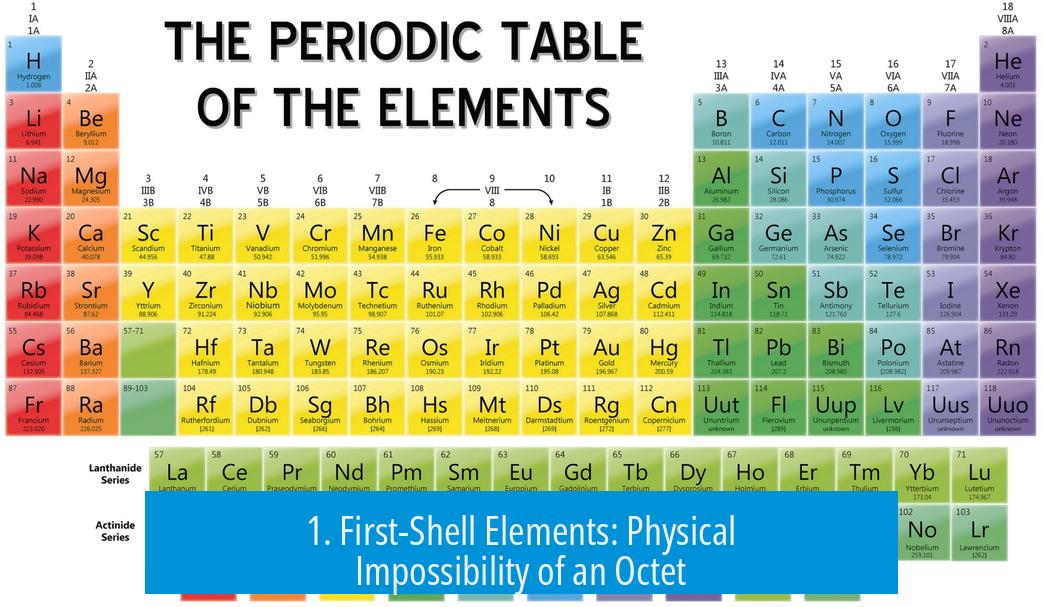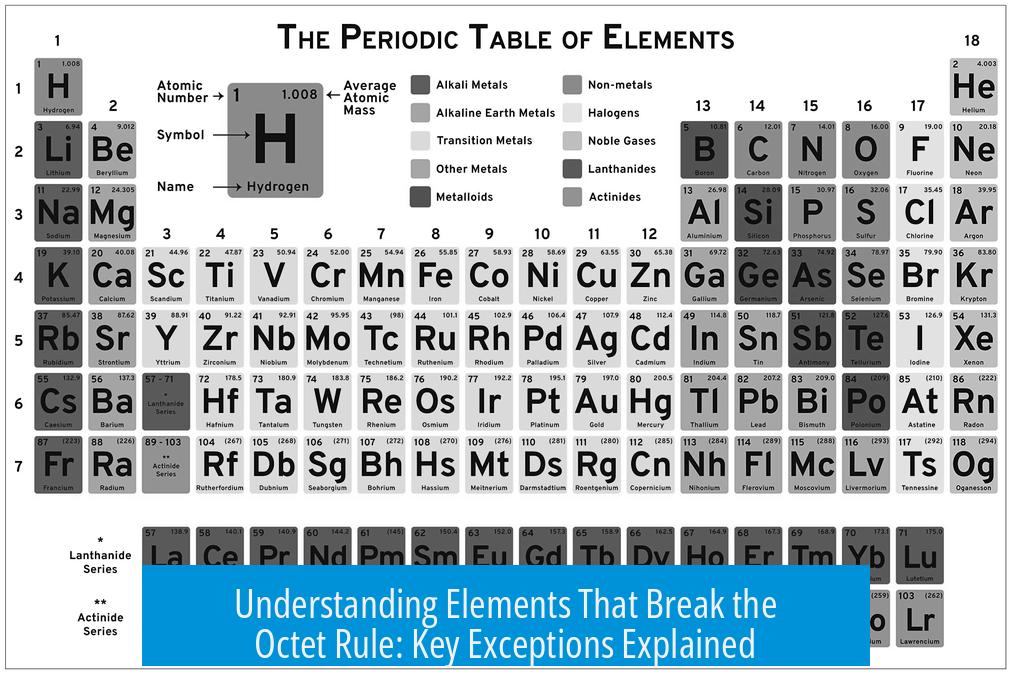What Elements Are Exceptions to the Octet Rule?

Elements that are exceptions to the octet rule include first-shell atoms such as hydrogen, helium, lithium, and beryllium; odd-electron molecules like nitric oxide; electron-deficient centers such as boron and aluminum; so-called expanded valence atoms like sulfur and phosphorus; and transition metals that exceed eight electrons due to d orbital involvement.
Understanding the Octet Rule
The octet rule states that atoms tend to form compounds in ways that give them eight valence electrons, achieving a noble gas electron configuration. This rule applies primarily to main group elements in the second period and beyond, particularly those in the s and p blocks. However, not all atoms strictly follow or can follow this rule due to their electronic structures or bonding situations.
1. First-Shell Elements: Physical Impossibility of an Octet

The atoms hydrogen (H), helium (He), lithium (Li), and beryllium (Be) occupy the first electron shell. This shell comprises only one s orbital and lacks p orbitals, so it cannot hold eight electrons. Therefore, these atoms cannot achieve an octet. This limit is a fundamental property of their atomic structure, not a chemical exception.
- Hydrogen forms stable molecules with just two electrons (a duet).
- Helium is stable with two electrons and does not form bonds.
- Lithium and beryllium have 1s orbital occupation and limited valence orbitals.
Because the first shell cannot hold eight electrons, these atoms are excluded from octet considerations. Chemists generally do not regard these as true exceptions to the octet rule but rather as a separate situation.
2. Odd-Electron Molecules
Some molecules contain an odd number of total electrons, which prevents all atoms from having eight electrons. These molecules possess unpaired electrons and are called free radicals.
- Example molecules: nitric oxide (NO), nitrogen dioxide (NO2), chlorine dioxide (ClO2).
- Each contains one unpaired electron, causing incomplete octets.
- These radicals are often reactive due to the presence of unpaired electrons.
Odd-electron molecules inherently violate the octet rule because electron pairing is impossible for all atoms in the molecule.
3. Electron-Deficient Atomic Centers
Some atoms, especially boron (B) and aluminum (Al), tend to form stable molecules where the central atom has fewer than eight valence electrons. These are called electron-deficient molecules.
- Typical examples include BF3 and AlCl3.
- Boron and aluminum often have only six valence electrons after forming covalent bonds.
- This electron deficiency leads to high reactivity and Lewis acidity.
Although electron-deficient atoms do not have octets, they seek to complete an octet through reactions, such as accepting electron pairs from donors. The incomplete octet reflects their bonding behavior rather than a fundamental exception.
4. Expanded-Valence Atomic Centers
Certain atoms in period 3 and beyond can appear to have more than eight electrons in their valence shell. Traditionally, this was explained by “expanded octet” theory allowing d orbitals to accommodate extra electrons. Common examples include sulfur in SF6 and phosphorus in PF5.
- Phosphorus pentafluoride (PF5) is described as having ten valence electrons around phosphorus.
- Sulfur hexafluoride (SF6) is described as having twelve valence electrons around sulfur.
However, modern research challenges this classic view:
- Evidence suggests sulfur and phosphorus do not significantly utilize d orbitals in bonding.
- Instead, resonance structures and delocalization better explain bonding without invoking expanded octets.
- The sulfate ion (SO42−) provides a key example where the bonding is best expressed through resonance rather than d orbital involvement.
Thus, “expanded octets” may be oversimplified or incorrect models of bonding for these atoms. They are often better understood with advanced bonding theories.
5. Transition Metals and d Orbitals
Transition metals have valence electrons in s and d orbitals, allowing them to host more than eight electrons around the central atom. In fact, many stable transition metal complexes follow the 18-electron rule rather than the octet rule.
- The 18-electron rule considers s, p, and d orbitals for an expanded valence shell.
- Transition metals often form complexes with 10 to 18 valence electrons.
- Half-filled and fully-filled d orbitals confer additional stability.
Because of these properties, transition metals do not obey the octet rule conventionally. Their stable states correspond to d orbital occupations that exceed eight electrons.
6. Main Group Elements and Octet Rule Limitations
Most discussions of octet rule exceptions concern main group elements in the s and p blocks, specifically period 2 (elements B through Ne) and beyond. Notably, first-row p-block elements never form expanded octet molecules.
Main group elements tend to follow the octet rule more strictly compared to transition metals. Nevertheless, bonding theories acknowledge that the octet rule is a guideline rather than a strict law. Many molecules violate the rule under certain conditions, influenced by electronic structure and molecular stability.
7. Reconsidering the Concept of Exceptions
Some chemists argue there are no true exceptions to the octet rule once the full chemical context is considered. The rule itself reflects a tendency toward stability associated with full valence shells, not a rigid law.
The so-called exceptions can be explained as:
- Atoms and molecules that are less stable due to incomplete octets.
- Bonding arrangements optimized for energy, electron configuration, and molecular shape.
- Situations influenced by orbital hybridization and electron delocalization beyond simple octets.
Thus, the “exceptions” arise from the chemical and physical realities of electron behavior in molecules rather than outright violations.
Summary Table of Elements and Molecules Related to Octet Rule Exceptions
| Category | Examples | Notes |
|---|---|---|
| First shell elements | H, He, Li, Be | No octet possible due to absence of p orbitals. |
| Odd-electron molecules | NO, NO2, ClO2 | Odd number of electrons produces unpaired electrons. |
| Electron-deficient centers | B, Al | Stable with fewer than 8 electrons; reactive. |
| Expanded valence centers (traditional view) | S in SF6, P in PF5 | Disputed belief of d orbital participation; modern bonding explained differently. |
| Transition metals | Various complexes | Often exceed 8 electrons; follow 18-electron rule. |
| Main group s and p block elements | B through Ne (period 2) | Do not form stable expanded-shell molecules. |
Key Takeaways
- Atoms in the first shell (H, He, Li, Be) cannot satisfy the octet rule due to limited orbital capacity.
- Odd-electron molecules exist with unpaired electrons, making complete octets impossible.
- Boron and aluminum often form electron-deficient compounds with incomplete octets.
- Classical ideas of expanded octets in sulfur and phosphorus are challenged by modern research.
- Transition metals frequently exceed the octet rule, following the 18-electron rule instead.
- Octet rule exceptions often correspond to less stable or reactive species, reflecting bonding and energetic considerations.
What Elements Are Exceptions to the Octet Rule? Unpacking the Truth
The simple answer? Many elements and molecules we call “exceptions” to the octet rule aren’t real exceptions in the strictest sense. They often reflect physical or chemical realities that the octet rule just can’t fully capture. But, let’s dive into the puzzle, because figuring out who really breaks the octet rule—and why—is the kind of chemistry detective work that’s pretty fascinating.
The octet rule claims that atoms tend to form bonds until they have eight electrons in their valence shell. It sounds neat, but the rule doesn’t hold for everyone.
The First Shell Element “Non-Exceptions”
Start with the smallest kids on the atomic block: hydrogen (H), helium (He), lithium (Li), and beryllium (Be). These guys cannot have an octet, simply because their valence shell is the first shell. The first shell has only one s orbital — no p orbitals to fill, no way to reach eight electrons. So it’s physically impossible for them to follow the octet rule.
This is not some exotic exception; it’s just basic physics. It’s like trying to fit eight people in a room that can only hold two. Chemists don’t usually consider this an “exception” because it’s more of a design limitation than a quirky rebel behavior.
| Element | Valence shell | Octet Rule Status |
|---|---|---|
| H | 1s | Impossible to have octet |
| He | 1s | Impossible to have octet |
| Li | 1s 2s | Impossible to fill octet in first shell |
| Be | 1s 2s | Impossible to fill octet in first shell |
Real Exceptions: The Three Main Categories
Now let’s meet the classic “exceptions” that chemistry students curse and love in equal measure:
- Odd-electron molecules: Molecules like nitric oxide (NO), nitrogen dioxide (NO2), and chlorine dioxide (ClO2) have an odd number of electrons, meaning one electron remains unpaired. This lone electron throws a wrench into forming a perfect set of eight electrons around every atom.
- Electron-deficient centers: Elements like boron (B) and aluminum (Al) often bond with fewer than eight electrons. These atoms never quite reach the octet and aren’t shy about it. Take boron trifluoride (BF3) for example—boron has only six valence electrons, making the molecule highly reactive.
- Expanded-valence centers: Sulfur and phosphorus sometimes form molecules where the central atom seems to hold more than eight electrons, such as sulfur hexafluoride (SF6) and phosphorus pentafluoride (PF5). But modern chemistry research challenges this classical idea.
Boron: The “Exception” Who’s Actually Just Trying Hard
Boron gets a lot of blame for breaking the octet rule. But here’s a little secret: boron wants to reach a full octet, just like everyone else. It just can’t always get there in stable compounds. That’s why boron compounds are often reactive—they are desperate for those missing electrons.
So, does this make boron a rule-breaker? Not exactly. Boron’s incomplete octet is a sign of instability, which means it’s fighting the octet rule rather than flaunting it.
The Great Sulfur Expansion Myth
You’ve heard the textbooks: sulfur can “expand” its octet using d orbitals to handle twelve electrons or more. That sounds like a wild party in the electron shell! However, recent research has debunked this idea.
Instead of sulfur actually holding more than eight electrons, the molecule’s true nature is better explained by resonance structures—where electrons don’t localize in one place but “roam” between bonds. In the sulfate ion (SO42-), for example, sulfur doesn’t expand its octet by using d orbitals. The bonds have partial double-bond character spread across the oxygens, satisfying electron requirements without breaking classical rules.
See sulfate’s Lewis structure discussion here.
Transition Metals: Playing by a Different Rulebook
Transition metals add a juicy twist. They have d orbitals, which allows them to host more than eight electrons around them. But they don’t just go wild—they follow the 18-electron rule for stability in many cases.
So rather than focusing on the octet, transition metal complexes stabilize themselves by filling the s, p, and d orbitals. If you’ve ever tried grasping the complicated world of transition metal bonding, you’ll know it’s more about chemistry orchestra than strict counting.
A funny detail: half-filled d orbitals contribute to stability, so the electron count isn’t always a straightforward “more is better” scenario. It’s a delicate balance, like tuning an old radio to the clearest signal.
Main Group Elements: S and P Block Stick to the Octet Mostly
Among main group elements—think groups 1, 2, and the p block—exceptions to the octet rule are usually few. First-row p block elements (boron through neon) almost never form stable species with expanded valence shells. They stick closely to the octet because their smaller size and lack of accessible d orbitals limit electron configurations.
Is There Really Such a Thing as an “Exception”?
Let’s get philosophical. The octet rule is a handy guideline, a rule of thumb to explain common bonding patterns. It’s not a law engraved in stone.
The so-called “exceptions” often are just atoms or molecules that don’t comfortably reach a full octet. That’s a signal they’re less stable or more reactive, not necessarily breaking a fundamental rule.
Chemistry is about energy minimization. Atoms bond in ways that lower the system’s energy. Sometimes that means full octets, sometimes it means odd electrons or fewer electrons, and sometimes it’s more complicated.
Current understanding tells us the octet rule oversimplifies a complex quantum dance of electrons. It’s a great starting point but can’t capture weirdness like helical molecular orbitals or subtle resonance effects.
A Handy Summary Table
| Category | Examples | Why “Exception”? |
|---|---|---|
| First shell elements | H, He, Li, Be | Physically impossible to have octet; shells lack p orbitals |
| Odd-electron molecules | NO, NO2, ClO2 | Odd number of electrons; unpaired electron prevents complete octet |
| Electron-deficient centers | B, Al | Often stable with fewer than 8 valence electrons; molecules reactive |
| Expanded valence shell centers | S in SF6, P in PF5 | Previously thought to break octet; modern research disputes d orbital involvement |
| Transition metals | Various complexes | Use d orbitals; follow 18-electron rule, not octet; multiple stable configurations |
| Main group s and p block elements | B through Ne | Never form stable expanded valence shells |
What Can We Learn from All This?
If you’re a chemistry student or just a curious mind, here’s the takeaway:
- The octet rule is a useful but simplified model. Treat it like a helpful friend who sometimes misses the bigger picture.
- Not all “exceptions” are rebellious rule-breakers. Some are just bound by their fundamental atomic structure or are in a tug-of-war to reach stability.
- Transition metals and heavier elements play by different rules. The 18-electron rule or resonance structures are better explanations than forcing everything into an octet mold.
- Chemistry evolves. What textbook narratives told you about sulfur expanding its octet is now challenged by research. Science loves to revise itself!
- Dig deeper into molecular orbital theory. Understanding energy, electron distribution, and quantum effects gives richer insights than memorizing exceptions.
So next time you hear about “exceptions to the octet rule,” you can smile knowingly. They’re not so much exceptions as parts of a colorful, complex, and cool chemical world that defies simple rules—reminding us that chemistry is as much art as science.
Which elements cannot follow the octet rule due to their electron shell structure?
Hydrogen, Helium, Lithium, and Beryllium cannot follow the octet rule. Their first electron shell lacks p orbitals, making it physically impossible to hold eight electrons.
What types of molecules are considered common exceptions to the octet rule?
Odd-electron molecules like NO, NO2, and ClO2 are exceptions. These molecules have an unpaired electron, preventing a complete octet around some atoms.
Why are Boron and Aluminum considered exceptions to the octet rule?
They often form stable compounds with fewer than eight electrons around them. Boron’s incomplete octet makes its compounds reactive but it still tends toward a full shell.
Is the concept of sulfur having expanded octets supported by modern research?
No. Evidence shows sulfur does not use d orbitals to form expanded octets. Structures like sulfate are better explained by resonance, not expanded valence shells.
How do transition metals relate to the octet rule exceptions?
Transition metals can have more than eight electrons due to d orbitals. They often follow an 18-electron rule for stability, which goes beyond the octet concept.





Leave a Comment